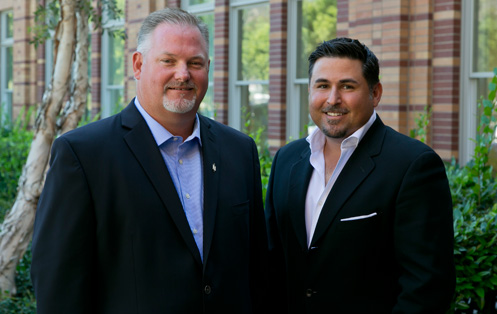Globest.com: Being ‘Market Agnostic’ Distinguishes Firm

By Carrie Rossenfeld
LADERA RANCH, CA—Cypress West Partners principals Jeff Johnson and Chris Cumella tell GlobeSt.com exclusively that they would rather be affiliated with a top hospital or medical group in a secondary market than a lesser-ranked entity in a primary market. This is one of the ways the firm sets itself apart from others in the healthcare real estate field.
Cypress West, which is looking to wrap up approximately $100 million in transactions by the end of this year, just acquired Mission Health Center, a 23,280-square-foot, two-story medical-office building at 22032 El Paseo in Rancho Santa Margarita, CA, from PNC Bank for $7.8 million. Dan Vittone and Alan Pekarcik of Avison Young represented the seller in the transaction, which puts Cypress West’s portfolio at 321,000 square feet of healthcare properties located throughout the Western US. GlobeSt.com spoke with Cumella and Johnson about the acquisition, how it fits into the firm’s overall strategy for healthcare properties and the investment market for healthcare overall.
GlobeSt.com: What stands out about Mission Health Center for your and your firm?
Cumella: It’s the only true medical-office building in that surrounding area. It has an affiliation with the largest hospital in the area, Mission Hospital, and is amongst one of the strongest zip codes as far as house values, education and employment go—which is what we look at. We do a lot of demographic research before we make an acquisition.
GlobeSt.com: What is your acquisition strategy for healthcare properties?
Cumella: Strong hospital affiliation, larger physician groups. We coined a phrase around here that we’re market agnostic—it doesn’t have to be a top MSA; we’d rather be affiliated with a top hospital and a top doctor group in a secondary or tertiary market.
Johnson: Part of the reason for that is when we started this, we looked to see if a property was within an hour drive or flight so we could own it and operate it effectively, so we’ve kept ourselves in California and Arizona, and we’ve looked at Nevada.
Cumella: This allowed us to react fast and uphold our value proposition to our equity partners to be their eyes and ears and day-to-day- management. If a property were outside that area, it would be difficult to do that.
Johnson: We’ve done third-party management one-on-one, and we’re looking to expand that in 2015.
Cumella: We do it all, but we provide those services when we’re not the acquirer, too. We’re also a for-hire third-party acquirer for other owners, but now we’re busy acquiring.
GlobeSt.com: What is the niche you hope to create for our business, and how do you plan to develop it?
Cumella: Just focusing on MOB in healthcare is a pretty exclusive club. Not a lot of companies have c hosen this distinct product type. They may have senior housing, assisted living, skilled nursing and other healthcare properties, but we are strictly an MOB operator. That’s pretty specific in the realm of real estate, honing in on one geographic area and product type. I would say this product type demands and deserves differentiation. It’s unlike any other, and there is a lot of work to do at these properties. Each is unique and needs that much attention.
There’s at least one of three criteria we look for when acquiring medical-office buildings: 1. it’s on a hospital campus; 2. it’s adjacent to a hospital campus adjacent; 3. there’s a hub-and-spoke reach into a community.
The Rancho Santa Margarita acquisition represents the “retailization” of medical. It makes sense because retailers and health systems are competitive businesses, so they understand how to use real estate to plant their flag. The sites retail developers looked at years ago are now being looked at by hospitals.
GlobeSt.com: Where are the strongest geographical areas in Orange County for healthcare properties, and why?
Cumella: It follows the demographics and the affiliations. All hospitals publicly publish their revenues, and the hospitals with the highest revenues have the most real estate and the most doctors. They are high-velocity campuses. We tend to gravitate toward those hospitals and markets. There’s a need for other hospitals, but we simply try to align ourselves with the number-one or number-two system in an area—maybe the third. After that, we would probably pass on those hospital systems. South Orange County has a lot of these hospitals, with MemorialCare and Hoag, and Kaiser is picking up a big presence here as well.
GlobeSt.com: How is the investment market for healthcare overall?
Cumella: It’s outperformed many of the other asset classes, and a light is being shined on the space, coupled with all the changes to insurance and the Affordable Care Act. I joke that more money is being raised to be placed in this space than there are investable assets. That’s home much money is coming into the space. A total of 5% of all real estate assets could be classified as healthcare real estate assets, and a small piece of that universe is getting a lot of attention from institutional equity. It performed so well in the last cycle—there’s a silver tsunami, a demographic shift to the aging Baby Boomers, so it makes sense to have an allocation for healthcare.
There is great fragmentation and regionalization in healthcare real estate investment. Even with all of the institutions buying, they’re accumulating no more than 10%. Local owners, developers and hospital systems are all buyers, so it’s not even close to being an institutional-size space. Healthcare real estate is all new, so the institutions hadn’t been buying before. It used to be office buildings with doctors in suites—not there are medical funds for this space. It’s all grown up.